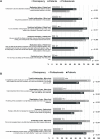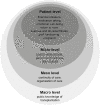A National Survey Comparing Patients' and Transplant Professionals' Research Priorities in the Swiss Transplant Cohort Study
- PMID: 35664427
- PMCID: PMC9156624
- DOI: 10.3389/ti.2022.10255
A National Survey Comparing Patients' and Transplant Professionals' Research Priorities in the Swiss Transplant Cohort Study
Abstract
We aimed to identify, assess, compare and map research priorities of patients and professionals in the Swiss Transplant Cohort Study. The project followed 3 steps. 1) Focus group interviews identified patients' (n = 22) research priorities. 2) A nationwide survey assessed and compared the priorities in 292 patients and 175 professionals. 3) Priorities were mapped to the 4 levels of Bronfenbrenner's ecological framework. The 13 research priorities (financial pressure, medication taking, continuity of care, emotional well-being, return to work, trustful relationships, person-centredness, organization of care, exercise and physical fitness, graft functioning, pregnancy, peer contact and public knowledge of transplantation), addressed all framework levels: patient (n = 7), micro (n = 3), meso (n = 2), and macro (n = 1). Comparing each group's top 10 priorities revealed that continuity of care received highest importance rating from both (92.2% patients, 92.5% professionals), with 3 more agreements between the groups. Otherwise, perspectives were more diverse than congruent: Patients emphasized patient level priorities (emotional well-being, graft functioning, return to work), professionals those on the meso level (continuity of care, organization of care). Patients' research priorities highlighted a need to expand research to the micro, meso and macro level. Discrepancies should be recognized to avoid understudying topics that are more important to professionals than to patients.
Keywords: organ transplantation; patient involvement; qualitative methods; registry-based study; research priorities.
Copyright © 2022 Beckmann, Mauthner, Schick, Rochat, Lovis, Boehler, Binet, Huynh-Do, De Geest, the Psychosocial Interest Group, and the Swiss Transplant Cohort Study.
Conflict of interest statement
The authors declare that the research was conducted in the absence of any commercial or financial relationships that could be construed as a potential conflict of interest.
Figures
References
-
- INVOLVE. Briefing Notes for Researchers: Involving the Public in NHS, Public Health and Social Care Research: Involve (2012). Available from: https://www.invo.org.uk/posttypepublication/involve-briefing-notes-for-r... (Accessed on August 11, 2019).
-
- International Alliance of Patients’ Organizations. IAPO Strategy 2019-2021 (2019). Available from: https://www.iapo.org.uk/strategy (Accessed on August 11, 2019).
-
- Strategy for Patient Oriented Research. Patient Engagement Framework. Canada: Government of Canada; (2014).



